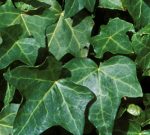 This evergreen climbing vine is a member of the Aralia family, Araliaceae, that also includes Fatsia and Schefflera and is native to most of Europe and western Asia where it grows in waste spaces and on walls and tree trunks. Growing up to 98’ long, this vine produces aerial rootlets with matted pads that cling tightly to various surfaces. The dark green leaves are waxy and have conspicuous white veins. Young leaves are palmately five-lobed while older leaves on flowering stems in full sun are unlobed and cordate. The small greenish-yellow flowers are produced in umbels up to 2” wide from late summer to late fall and are followed by .3” wide black-purple fruits attractive to wildlife. Ivy is considered invasive in many areas and can do serious damage to stucco, wood, brick mortar, and aluminum siding.
This evergreen climbing vine is a member of the Aralia family, Araliaceae, that also includes Fatsia and Schefflera and is native to most of Europe and western Asia where it grows in waste spaces and on walls and tree trunks. Growing up to 98’ long, this vine produces aerial rootlets with matted pads that cling tightly to various surfaces. The dark green leaves are waxy and have conspicuous white veins. Young leaves are palmately five-lobed while older leaves on flowering stems in full sun are unlobed and cordate. The small greenish-yellow flowers are produced in umbels up to 2” wide from late summer to late fall and are followed by .3” wide black-purple fruits attractive to wildlife. Ivy is considered invasive in many areas and can do serious damage to stucco, wood, brick mortar, and aluminum siding.
The Greeks dedicated ivy to Bacchus and the Romans hung sprays of ivy outside the door of taverns that sold wine.
II Maccabees 6.7 (CEB) Antiochus Epiphanes oppresses the Jews.
” … out of bitter necessity, they [the Jews] had to observe the birthday of the king each month by eating the organs of sacrificial animals. When the Festival of Dionysus arrived, they were forced to take part in a procession honoring Dionysus, holding ivy wreaths.”
Ivy likes part to full shade in aerage, medium moist, well drained soil in USDA Hardiness zones 4-9, but tolerates drought. Propagatiion is by semi-hardwood cuttings and seed. Plants are susceptible to damage by aphids, caterpillars, loopers, mealybugs, mites, scale, bacterial leaf spot, canker, leaf spot, powdery mildew and stem rot. Ivy makes a good ground cover in difficult sites and is also attractive growing on trellis’, fences, and walls. Many cultivars are available that are less vigorous than the species and make excellent houseplants and topiary.
The genus name, Hedera, is the ancient Latin name for ivy and comes from the Greek word χανδάνω (khandánō) meaning to grasp and refers to the aerial rootlets with matted pads by which the vine climbs. The specific epithet, helix, is the ancient Greek word ἕλιξ (elix), meaning spiral and refers to the growth pattern.